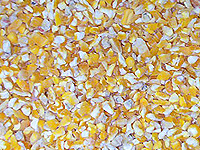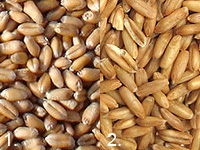| Feed List | ||

Whole corn forms the base diet for most of our
adult birds. Corn makes a good staple feed for poultry bec-ause
it is high in nutrition, such that it even forms the base diet for
human populations in many parts of the world. |

Cracked corn makes up the standard diet of most of our juvenile
birds and those adult birds that refuse to eat whole corn. Finely
ground corn is mixed with starter feed to form the standard diet
for our chicks. |

Manufactured poultry feed, in its various forms, is fed to our birds
as a complement to their standard diet of corn. With respect to
our juvenile birds and chicks, it helps greatly in optimizing their
health and growth. It also plays a crucial role with regard to our
laying hens, who require a rich, high protein diet in order to lay
healthy eggs. |

Uncooked rice grains are occas-ionally offered
to our birds. In Thailand and throughout most of Southeast Asia,
however, rice is oftentimes the primary feed given to these birds
since it is usually the most abundant feed item available. Cooked
rice is offered as a supple-ment and a treat to our young chicks
and juvenile birds. |

Wheat (1) and oat (2) grains offer a good source
of nutrition, and like uncooked rice grains, are occas-ionally fed
to our birds. |
|
 Of course, regardless of what kind of feed is used, one must never underestimate the importance of letting these birds free-range, especially when they are young. A grasshopper or two here and a few blades of grass there will help exponentially in increasing the health, growth, and vitality of chicks and juvenile birds. This is not to mention that free-ranging also goes a long way in increasing coordination and improving muscle and bone development. Through the years, we have been able to observe these effects first-hand. Chicks that are allowed to roam without limits tend to grow more evenly and are more alert and energetic than those that are "cooped-up," even in cases where the confined chicks are fed a more nutritious diet than their free-ranging counterparts. |
||